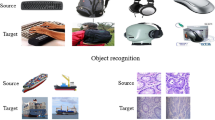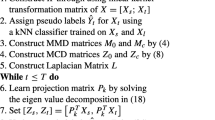Abstract
Domain adaptation is a representative problem in transfer learning, which aims to tackle the problem of insufficient labeled data in a target domain by exploiting discriminant information from a labeled source domain. Since the source and target domains follow different distributions, source domain data are uncertain with respect to the target domain. Ignoring the uncertainty may lead to unreliable label prediction for the target domain. Despite the many studies that have been done on domain adaptation, most have ignored the adverse impact of uncertain and noisy data on learning an adaptive classifier. Regarding these issues, the present paper introduces a robust to noise domain adaptation method by extending the quarter-sphere SVM classifier. Essentially, the proposed method builds an individual classifier for each available class per domain. Also, a belief theory-based weighting approach is designed to provide noise robustness. The strength of the proposed method is that after constructing and training the source domain classifiers, accessibility to the source domain data is not required, and the existence of only the source domain hyperspheres is sufficient. The effectiveness of the proposed method has been compared to the state-of-the-art methods on 15 tasks taken from two benchmark datasets. The experimental results demonstrate the superiority of the proposed method over state-of-the-art ones in terms of classification accuracy and computational time. Besides, the noise analysis proves the robustness of the proposed method. To prove a meaningful distinction between the evaluation metrics results of the proposed method and the competing ones, the Wilcoxon statistical test has been conducted.








Similar content being viewed by others
References
Fan C, He W, Liu Y, Xue P, Zhao Y (2022) A novel image-based transfer learning framework for cross-domain HVAC fault diagnosis: from multi-source data integration to knowledge sharing strategies. Energy Build 262:111995. https://doi.org/10.1016/j.enbuild.2022.111995
Pan T, Chen J, Ye Z, Li A (2022) A multi-head attention network with adaptive meta-transfer learning for RUL prediction of rocket engines. Reliabil Eng Sys Safety. https://doi.org/10.1016/j.ress.2022.108610
Almanifi ORA, Ab Nasir AF, Mohd Razman MA, Musa RM, Majeed APP (2022) Heartbeat murmurs detection in phonocardiogram recordings via transfer learning. Alex Eng J 61(12):10995–11002. https://doi.org/10.1016/j.aej.2022.04.031
Prabono AG, Yahya BN, Lee S-L (2022) Multiple-instance domain adaptation for cost-effective sensor-based human activity recognition. Futur Gener Comput Syst 133:114–123. https://doi.org/10.1016/j.future.2022.03.006
Shan Y, Lu WF, Chew CM (2019) Pixel and feature level based domain adaptation for object detection in autonomous driving. Neurocomputing 367:31–38. https://doi.org/10.1016/j.neucom.2019.08.022
Pan SJ, Yang Q (2009) A survey on transfer learning. IEEE Trans Knowl Data Eng 22(10):1345–1359
Zhang L, Gao X (2019) Transfer adaptation learning: a decade survey. arXiv preprint arXiv:190304687
Xu Y, Pan SJ, Xiong H, Wu Q, Luo R, Min H, Song H (2017) A unified framework for metric transfer learning. IEEE Trans Knowl Data Eng 29(6):1158–1171
Chen S, Han L, Liu X, He Z, Yang X (2020) Subspace distribution adaptation frameworks for domain adaptation. IEEE Trans Neural Netw Learn Sys 31(12):5204–5218
Li S, Song S, Huang G (2016) Prediction reweighting for domain adaptation. IEEE Trans Neural Netw Learn Sys 28(7):1682–1695
Khalighi S, Ribeiro B, Nunes UJ (2016) Importance weighted import vector machine for unsupervised domain adaptation. IEEE Trans Cybern 47(10):3280–3292
Kundu JN, Venkat N, Babu RV (2020) Universal source-free domain adaptation. pp 4544–4553
Liang J, Hu D, Feng J Do (2020) we really need to access the source data? source hypothesis transfer for unsupervised domain adaptation PMLR, pp 6028–6039
Kundu JN, Venkat N, Revanur A, Babu RV (2020) Towards inheritable models for open-set domain adaptation. pp 12376–12385
Li R, Jiao Q, Cao W, Wong H-S, Wu S (2020) Model adaptation: unsupervised domain adaptation without source data. pp 9641–9650
Yang J, Yan R, Hauptmann AG (2007) Cross-domain video concept detection using adaptive svms. Paper presented at the Proceedings of the 15th ACM international conference on Multimedia, Augsburg, Germany
Yang J, Yan R, Hauptmann AG (2007) Adapting SVM classifiers to data with shifted distributions. 17th IEEE international conference on data mining workshops (ICDMW 2007), pp 69–76. https://doi.org/10.1109/ICDMW.2007.37
Wei J, Zavesky E, Shih-Fu C, Loui A (2008) Cross-domain learning methods for high-level visual concept classification. 15th IEEE International conference on image processing, pp 161–164. https://doi.org/10.1109/ICIP.2008.4711716
Aytar Y, Zisserman A (2011) Tabula rasa: model transfer for object category detection. International conference on computer vision, 2011. pp 2252–2259. https://doi.org/10.1109/ICCV.2011.6126504
Matasci G, Tuia D, Kanevski M (2012) SVM-based boosting of active learning strategies for efficient domain adaptation. IEEE J Select Topics Appl Earth Observ Remote Sens 5(5):1335–1343. https://doi.org/10.1109/JSTARS.2012.2202881
Sun Z, Wang C, Wang H, Li J (2013) Learn multiple-kernel SVMs for domain adaptation in hyperspectral data. IEEE Geosci Remote Sens Lett 10(5):1224–1228. https://doi.org/10.1109/LGRS.2012.2236818
Sun B, Feng J, Saenko K (2016) Return of frustratingly easy domain adaptation. Proceedings of the AAAI conference on artificial intelligence, Vol 1
Xue Y, Beauseroy P (2017) Transfer learning for one class SVM adaptation to limited data distribution change. Patt Recogn Lett 100:117–123. https://doi.org/10.1016/j.patrec.2017.10.030
Lv Y, Zhang B, Zou G, Yue X, Xu Z, Li H (2022) Domain adaptation with data uncertainty measure based on evidence theory. Entropy 24(7):966
Jayadeva KR, Chandra S (2007) Twin support vector machines for pattern classification. IEEE Trans Pattern Anal Mach Intell 29(5):905–910. https://doi.org/10.1109/TPAMI.2007.1068
Ding S, Zhang N, Zhang X, Wu F (2017) Twin support vector machine: theory, algorithm and applications. Neural Comput Appl 28(11):3119–3130
Li Y, Sun H, Yan W (2022) Domain adaptive twin support vector machine learning using privileged information. Neurocomputing 469:13–27
Maddox WJ, Izmailov P, Garipov T, Vetrov DP, Wilson AG (2019) A simple baseline for bayesian uncertainty in deep learning. Adv Neur Inf Process Sys, 32
Pan L, Deng Y (2018) A new belief entropy to measure uncertainty of basic probability assignments based on belief function and plausibility function. Entropy. https://doi.org/10.3390/e20110842
Jiroušek R, Shenoy PP (2018) A new definition of entropy of belief functions in the Dempster–Shafer theory. Int J Approx Reason 92:49–65. https://doi.org/10.1016/j.ijar.2017.10.010
Fu C, Chang W, Liu W, Yang S (2019) Data-driven group decision making for diagnosis of thyroid nodule. Sci China Inf Sci 62(11):212205. https://doi.org/10.1007/s11432-019-9866-3
Liu ZG, Pan Q, Dezert J, Martin A (2018) Combination of classifiers with optimal weight based on evidential reasoning. IEEE Trans Fuzzy Syst 26(3):1217–1230. https://doi.org/10.1109/TFUZZ.2017.2718483
Bossman A, Umar Z, Agyei SK, Junior PO (2022) A new ICEEMDAN-based transfer entropy quantifying information flow between real estate and policy uncertainty. Res Econ. https://doi.org/10.1016/j.rie.2022.07.002
Zadeh LA (1965) Fuzzy sets. Inf Control 8(3):338–353. https://doi.org/10.1016/S0019-9958(65)90241-X
Hamidzadeh J, Rezaeenik E, Moradi M (2021) Predicting users’ preferences by fuzzy rough set quarter-sphere support vector machine. Appl Soft Comp 112:107740. https://doi.org/10.1016/j.asoc.2021.107740
Shafer G (1976) A mathematical theory of evidence, vol 42. Princeton University Press, Princeton
Smets P (1990) The combination of evidence in the transferable belief model. IEEE Trans Patt Anal Mach Intell 12(5):447–458
Hamidzadeh, J., Moradi, M. (2020). Enhancing data analysis: uncertainty-resistance method for handling incomplete data. Applied Intelligence, 50(1):74–86.
Motiian S, Piccirilli M, Adjeroh DA, Doretto G (2017) Unified deep supervised domain adaptation and generalization. pp 5715–5725
Xie X, Sun S, Chen H, Qian J (2018) Domain adaptation with twin support vector machines. Neural Process Lett 48(2):1213–1226
Mozafari AS, Jamzad M (2016) A SVM-based model-transferring method for heterogeneous domain adaptation. Patt Recogn 56:142–158
Gao P, Wu W, Li J (2021) Multi-source fast transfer learning algorithm based on support vector machine. Appl Intell. https://doi.org/10.1007/s10489-021-02194-9
Ganin Y, Ustinova E, Ajakan H, Germain P, Larochelle H, Laviolette F, Marchand M, Lempitsky V (2016) Domain-adversarial training of neural networks. J Mach Learn Res 17(1):2096–2030
Damodaran BB, Kellenberger B, Flamary R, Tuia D, Courty N (2018) Deepjdot: deep joint distribution optimal transport for unsupervised domain adaptation. pp 447–463
Hong C, Zeng Z, Xie R, Zhuang W, Wang X (2018) Domain adaptation with low-rank alignment for weakly supervised hand pose recovery. Signal Process 142:223–230. https://doi.org/10.1016/j.sigpro.2017.07.032
Chen S., Hong Z., Harandi M., Yang X. (2022) Domain Neural Adaptation. IEEE Transactions on Neural Networks and Learning Systems, https://doi.org/10.1109/TNNLS.2022.3151683.
Xu X, Zhou X, Venkatesan R, Swaminathan G, Majumder (2019) O d-sne: Domain adaptation using stochastic neighborhood embedding. pp 2497–2506
Wang Z, Du B, Guo Y (2019) Domain adaptation with neural embedding matching. IEEE Trans Neural Netw Learn Sys 31(7):2387–2397
Yang S, Wang Y, van de Weijer J, Herranz L, Jui S (2021) Generalized source-free domain adaptation. pp 8978–8987
Yan H, Ding Y, Li P, Wang Q, Xu Y, Zuo W (2017) Mind the class weight bias: weighted maximum mean discrepancy for unsupervised domain adaptation. Proceedings of the IEEE conference on computer vision and pattern recognition, pp 2272–2281
Chen Y, Song S, Li S, Wu C (2019) A graph embedding framework for maximum mean discrepancy-based domain adaptation algorithms. IEEE Trans Image Process 29:199–213
Kumagai A, Iwata T (2019) Unsupervised domain adaptation by matching distributions based on the maximum mean discrepancy via unilateral transformations. Proceedings of the AAAI Conference on Artificial Intelligence, pp 4106–4113
Sun B, Saenko K (2016) Deep coral: Correlation alignment for deep domain adaptation. European conference on computer vision, Springer, pp 443–450
Sun B, Feng J, Saenko K (2016) Return of frustratingly easy domain adaptation. In: Proceedings of the AAAI conference on artificial intelligence
Sun B, Feng J, Saenko K (2017) Correlation alignment for unsupervised domain adaptation. Domain adaptation in computer vision applications. Springer, Berlin, pp 153–171
Pan SJ, Tsang IW, Kwok JT, Yang Q (2010) Domain adaptation via transfer component analysis. IEEE Trans Neural Networks 22(2):199–210
Gao J, Fan W, Jiang J, Han J (2008) Knowledge transfer via multiple model local structure mapping. Proceedings of the 14th ACM SIGKDD international conference on Knowledge discovery and data mining, pp 283–291
Ghifary M, Balduzzi D, Kleijn WB, Zhang M (2016) Scatter component analysis: a unified framework for domain adaptation and domain generalization. IEEE Trans Pattern Anal Mach Intell 39(7):1414–1430
Chen S, Harandi M, Jin X, Yang X (2020) Domain adaptation by joint distribution invariant projections. IEEE Trans Image Process 29:8264–8277
M. Long, Z. Cao, J. Wang, and M. I. Jordan, “Conditional adversarial domain adaptation,” in Proc. 32nd Annu. Conf. Neural Inf. Process. Syst., Montreal, QC, Canada, Dec. 2018, pp. 1640–1650.
Liu H, Shao M, Ding Z, Fu Y (2018) Structure-preserved unsupervised domain adaptation. IEEE Trans Knowl Data Eng 31(4):799–812
Laskov P, Schäfer C, Kotenko I, Müller KR (2004) Intrusion detection in unlabeled data with quarter-sphere support vector machines 27(4):228–236 doi https://doi.org/10.1515/PIKO.2004.228
Denœux T, Masson M-H (2012) Evidential reasoning in large partially ordered sets. Ann Oper Res 195(1):135–161
Pan SJ, Tsang IW, Kwok JT, Yang Q (2011) Domain adaptation via transfer component analysis. IEEE Trans Neural Networks 22(2):199–210. https://doi.org/10.1109/TNN.2010.2091281
Peng X, Bai Q, Xia X, Huang Z, Saenko K, Wang B (2019) Moment matching for multi-source domain adaptation. pp 1406–1415
Mikolov T, Chen K, Corrado G, Dean J (2013) Efficient estimation of word representations in vector space. arXiv preprint arXiv:13013781
Arora S, Liang Y, Ma T (2019) A simple but tough-to-beat baseline for sentence embeddings. In: International conference on learning representations
Gong B, Shi Y, Sha F, Grauman K (2012) Geodesic flow kernel for unsupervised domain adaptation. In: IEEE Conference on Computer Vision and Pattern Recognition, IEEE, pp 2066–2073
Sheskin DJ (2007) Handbook of parametric and nonparametric statistical procedures. Chapman & Hall/CRC, Boca Raton
Author information
Authors and Affiliations
Contributions
Mona Moradi: Writing - original draft, Resources. Software, Data curation, Writing – review & editing. Javad Hamidzadeh: Conceptualization, Methodology, Validation, Investigation. All authors reviewed the manuscript.
Corresponding author
Ethics declarations
Competing interests
The authors declare no competing interests.
Conflict of interest
The authors declare that they have no conflict of interest.
Additional information
Publisher's Note
Springer Nature remains neutral with regard to jurisdictional claims in published maps and institutional affiliations.
Rights and permissions
Springer Nature or its licensor (e.g. a society or other partner) holds exclusive rights to this article under a publishing agreement with the author(s) or other rightsholder(s); author self-archiving of the accepted manuscript version of this article is solely governed by the terms of such publishing agreement and applicable law.
About this article
Cite this article
Moradi, M., Hamidzadeh, J. A domain adaptation method by incorporating belief function in twin quarter-sphere SVM. Knowl Inf Syst 65, 3125–3163 (2023). https://doi.org/10.1007/s10115-023-01857-y
Received:
Revised:
Accepted:
Published:
Issue Date:
DOI: https://doi.org/10.1007/s10115-023-01857-y




